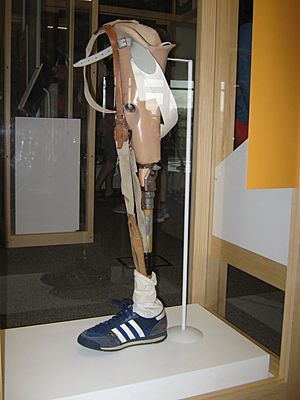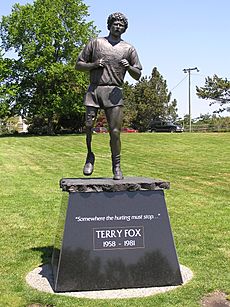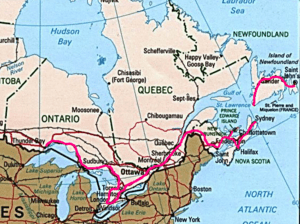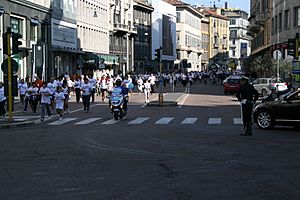Terry Fox facts for kids
Quick facts for kids
Terry Fox
|
|
|---|---|

Terry Fox in Toronto during his Marathon of Hope cross-country run (July 1980)
|
|
| Born |
Terrance Stanley Fox
July 28, 1958 |
| Died | June 28, 1981 (aged 22) New Westminster, British Columbia, Canada
|
| Cause of death | Metastatic osteosarcoma |
| Education | Simon Fraser University |
| Known for | Marathon of Hope |
| Title | Companion of the Order of Canada |
Terrance Stanley Fox (July 28, 1958 - June 28, 1981) was a Canadian athlete and activist. He was born in Winnipeg, Manitoba. When he was 18, he lost one of his legs because of bone cancer.
Terry Fox is famous for his run called The Marathon of Hope. This amazing journey began on April 12, 1980. He started in St. John's, Newfoundland. His goal was to run across Canada using an artificial leg. He planned to run about 26 miles (42 kilometers) every day. This is the same length as a typical marathon.
He wanted to run all the way to Vancouver Island on the other side of Canada. His main goal was to raise money for cancer research. He hoped to collect 1 million Canadian dollars. Later, he aimed to raise one dollar for every person in Canada.
Many people supported Terry during his run. But on August 31, 1980, near Thunder Bay, Ontario, his cancer spread to his lungs. He had to stop running. Terry died on June 28, 1981, just a month before his 23rd birthday. He passed away in New Westminster, British Columbia (BC). In Canada, Terry Fox is seen as a true hero. People still hold runs in his honor every year. There is also a statue of him in Ottawa, Canada's capital city, near Parliament Hill.
Contents
Terry Fox's Early Life and Cancer
Terry Fox was born on July 28, 1958. His parents were Rolland and Betty Fox. He was born in Winnipeg, Manitoba. Terry had two brothers, Fred and Darrell, and a sister, Judith. His family moved to Surrey, British Columbia, in 1966. Then they settled in Port Coquitlam, in 1968. His parents taught him to be determined and strong.
As a child, Terry played soccer, rugby, and baseball. He loved basketball the most, even though he wasn't very good at it at first. His coach, Bob McGill, encouraged him to try distance running. Terry kept practicing basketball. In his last year of high school, he and his friend Doug Alward won the athlete of the year award.
Terry wasn't sure about going to college. But his mother convinced him to go to Simon Fraser University. He studied kinesiology, which is the study of body movement. He wanted to become a physical education teacher. He tried out for the junior varsity basketball team. He earned a spot because of his strong determination, even over more skilled players.
On November 12, 1976, Terry was driving home. He crashed into a pickup truck. His car was badly damaged, but he only had a sore right knee. In December, his knee hurt again. He ignored it until basketball season ended. By March 1977, the pain was very bad. He went to a hospital. Doctors told him he had osteosarcoma. This is a type of cancer that often starts near the knees.
He learned his leg had to be removed. He would also need chemotherapy treatment. Doctors said he had a 50 percent chance of surviving. Terry found out that just two years before, the chance of survival was only 15 percent. This big improvement showed him how important cancer research was.
Terry was very determined. Three weeks after his leg was removed, he was walking with an artificial leg. He had chemotherapy for 16 months. During this time, he saw other cancer patients suffer and die. This was very hard for him. Terry felt he owed his life to medical advances. He wanted to help other cancer patients find courage.
The Marathon of Hope
The night before his cancer surgery, Terry read an article about Dick Traum. Traum was the first person with an amputated leg to finish the New York City Marathon. Terry decided he would run to help cancer patients. He told his family he planned to run a marathon to raise money for cancer research. But secretly, he planned to run across all of Canada. He started training for 14 months as soon as he could.
Because of his artificial leg, Terry ran in a special way. He had to hop on his good leg to let the springs in his artificial leg reset. This training was painful. He got bone bruises and blisters on his stump. Terry found that after about 20 minutes of running, the pain would lessen. The run would then become easier.
On September 2, 1979, Terry ran in a 17-mile road race. It was in Prince George, British Columbia. He finished last, but everyone cheered for him. After the race, he told his family his full plan. Terry first hoped to raise $1 million. Then he aimed for $10 million. Finally, he wanted to raise $1 for each of Canada's 24 million people.
Getting Ready for the Run
On October 15, 1979, Terry wrote a letter to the Canadian Cancer Society. He told them about his goal to raise money for cancer research. He asked for help to get started. He didn't promise a cure for cancer. But he told them he believed in miracles.
Terry also sent letters to companies. He asked for donations for a vehicle, running shoes, and other costs. He asked for money to buy a special running leg. The Ford Motor Company gave him a camper van. Imperial Oil gave him fuel. Adidas gave him running shoes. Terry did not accept donations that came with conditions. He also refused requests for him to promote products. He wanted no one to profit from his run.
Running Across Canada
The Marathon of Hope began on April 12, 1980. Terry dipped his right leg in the Atlantic Ocean near St. John's, Newfoundland. He filled two bottles with ocean water. He planned to keep one as a souvenir. He would pour the other into the Pacific Ocean when he finished his journey in Victoria, British Columbia. Terry's friend, Doug Alward, supported him. Doug drove the van and cooked meals.
In the first few days, Terry faced strong winds, heavy rain, and a snowstorm. When he reached Port aux Basques, Newfoundland, the town gave him over $10,000. Terry faced more difficulties, including arguments with Doug. By the time they reached Nova Scotia, they were barely speaking. Terry arranged for his 17-year-old brother, Darrell, to join them.
Terry arrived in Montreal on June 22. He had completed one-third of his 5,000-kilometer journey. He had collected over $200,000 in donations. Around this time, Terry's run caught the attention of Isadore Sharp. He was the founder of Four Seasons Hotels and Resorts. Sharp had lost his son to cancer in 1978. He offered Terry free food and lodging at his hotels along the route.
Terry felt discouraged when donations were low. Sharp then promised to donate $2 for every mile Terry ran. He also convinced nearly 1,000 other companies to do the same. Terry wanted to arrive in Ottawa for Canada Day. This would help raise more money. So, he stayed in Montreal for a few extra days.
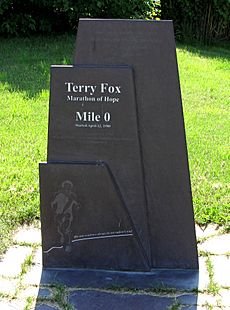
Terry crossed into Ontario at Hawkesbury, Ontario in late June. Here, he felt more encouraged by the excitement of Canadians. He continued to run 26 miles (42 kilometers) each day.
On July 11, a crowd of 10,000 people met Terry in Toronto. He was honored in Nathan Phillips Square. The Cancer Society estimated they collected $100,000 in donations that day alone.
Running a marathon every day was very hard on Terry's body. He refused to take a day off, even on his 22nd birthday. The only exceptions were rest days in Montreal requested by the Cancer Society. He often had shin splints and an inflamed knee. He also developed cysts on his stump and felt dizzy. At one point, his ankle hurt badly. He feared he had a stress fracture. But he ran for three more days before seeing a doctor. He was relieved to learn it was tendonitis, which could be treated with painkillers. Terry did not want regular medical checkups. He ignored warnings that he was risking his future health.
On September 1, outside Thunder Bay, Terry had to stop. He had a bad coughing fit and chest pains. He was unsure what to do. He kept running as crowds cheered him on. A few miles later, he was short of breath and still had chest pain. He asked Doug to drive him to a hospital. He immediately feared he had run his last kilometer. The next day, Terry held a press conference. He tearfully announced that his cancer had returned and spread to his lungs. He had to end his run after 143 days and 3,339 miles (5,374 kilometers). People offered to finish the race for him, but he refused. He said he wanted to complete his marathon himself.
Terry Fox's Death
In the months that followed, Terry received many chemotherapy treatments. However, the disease continued to spread. He was admitted to the Royal Columbian Hospital in New Westminster on June 19, 1981. He had chest congestion and pneumonia. He fell into a coma. Terry died at 4:35 a.m. PDT on June 28, 1981. His family was by his side.
The Canadian government ordered flags across the country to be lowered to half-staff. This is a rare honor, usually for respected political leaders. His funeral in Port Coquitlam was attended by 40 relatives and 200 guests. It was broadcast on national television. Hundreds of communities across Canada also held memorial services. Canadians again sent many donations to Cancer Society offices.
Terry Fox's Legacy
Terry Fox remains a hero to Canadians. His determination brought the nation together. He was an ordinary person who aimed for an extraordinary goal. He has been compared to a classic hero, Phidippides. Phidippides was the runner who delivered news of the Battle of Marathon before dying.
In September 2013, Dr. Jay Wunder, a cancer specialist, said that survival rates for osteosarcoma have greatly increased since Terry's death.
Famous Quotes from Terry Fox
- "I just wish people would realize that anything's possible if you try; dreams are made possible if you try."
- "I want to try the impossible to show that it can be done."
- "It took cancer to realize that being self-centered is not the way to live. The answer is to try and help others."
- "I bet some of you feel sorry for me. Well don't. Having an artificial leg has its advantages. I've broken my right knee many times and it doesn't hurt a bit."
- "I remember promising myself that should I live I would prove myself deserving of life."
Interesting Facts About Terry Fox
- Terry practiced basketball so much that he went from being poor at the sport to a starting player in 10th grade.
- Terry's grandmother on his mother's side was Métis. His younger brother Darrell has official Métis status.
- In the Fox home, play fighting was a normal thing.
- He played on a wheelchair basketball team. He was named an all-star by the North American Wheelchair Basketball Association in 1980.
- During the Marathon of Hope, Terry would wake up at 4:00 a.m. and start his run by 5:00 a.m.
- In his journal, he wrote, "I’d rather run in rain, snow, anything except against the wind."
- Because of his unusual running style, Terry never had to replace the shoe on his right artificial leg. But he wore out nine shoes on his good left leg.
- Instead of eating his 22nd birthday cake, Terry started throwing pieces of it. This began a food fight.
- Shortly before his death, he was made a Companion in the Order of Canada. He was the youngest person in the country to receive this honor.
- The annual Terry Fox Run started in 1981. It now has millions of participants in over 60 countries.
- Several schools are named after him.
- He has been featured on a Canadian $1 coin.
Images for kids
-
Memorial erected outside Thunder Bay on the Trans-Canada Highway near the spot where Fox was forced to end his marathon
See also
 In Spanish: Terry Fox para niños
In Spanish: Terry Fox para niños


